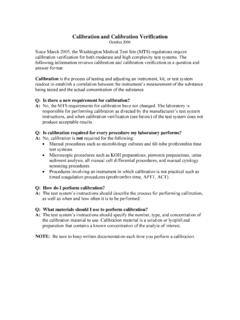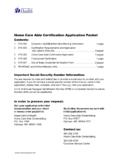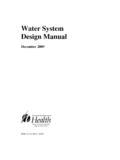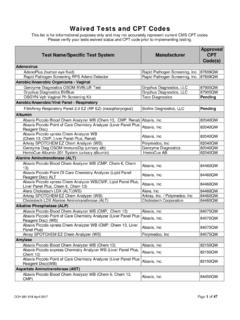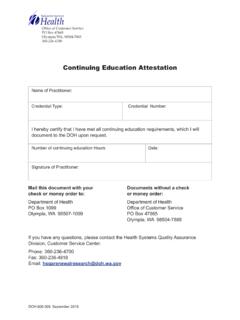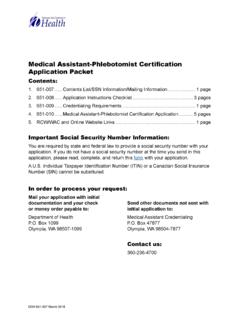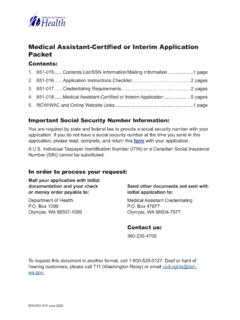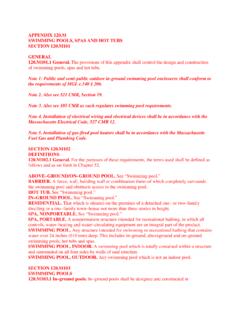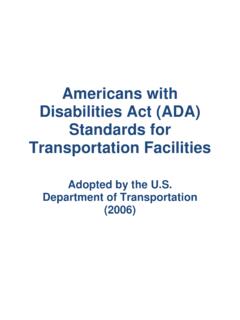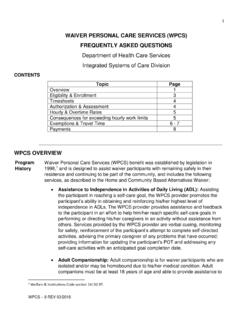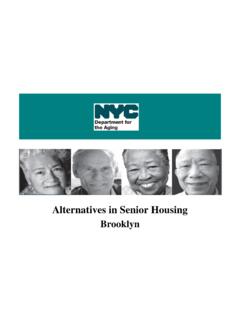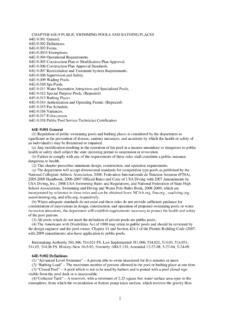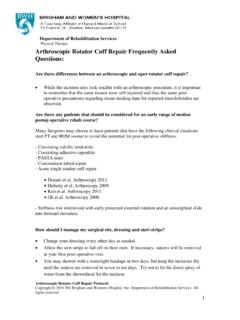Transcription of Sports and Fitness Guidance during COVID-19
1 Updated July 2, 2021 DOH 820-201 Sports and Fitness Guidance during COVID-19 Introduction This Guidance contains recommendations that are intended to help limit the spread of COVID-19 among people participating in sporting activities or Fitness training, any required activities are noted as such. This Guidance applies to school, recreational and club youth Sports and sporting activities indoor and outdoor, and adult recreational team Sports and sporting activities indoor and outdoor, including day and overnight Sports camps. This Guidance also applies to staffed indoor Fitness studios, individual Sports and Fitness training, group Fitness , gyms, and multi-use indoor Fitness facilities providing private instruction and access to personal Fitness training and/or specialized equipment; unstaffed indoor Fitness facilities in locations such as hotels and apartment buildings; and outdoor group Fitness classes.
2 Sports taking place in a child care program should also follow the Washington State Department of Health (DOH) Child Care, Youth Development, and Day Camps, and Sports overnight camps should also follow the Governor s Overnight Camp Guidance . K-12 schools are required to follow the K-12 COVID-19 Requirements for Summer 2021 and the 2021-2022 School Year Guidance . Employers should also refer to the DOH Non-Health Care Businesses and Organizations Guidance , Labor & Industries (L&I) COVID-19 Safety and Health Requirements and Guidance and Governor Inslee s Proclamation Programs, organizations, or businesses can choose to implement more protective measures, like requiring masks regardless of vaccination status, but they cannot be less protective than the requirements above. This is supported by the Secretary of Health s Mask Order, L&I directives, and Governor s COVID-19 Facial Covering Guidance for Employers and Businesses.
3 Individuals can also choose to wear masks even if fully vaccinated, and this choice should be supported. Prevention COVID-19 Safety Plan All sporting activities and Fitness centers should adopt a written procedure for employee safety and member interaction that is at least as strict as this Guidance . COVID-19 Coordinator Each Sports team and Fitness center should have a COVID-19 Coordinator. This person should serve as a point of contact within the team or Fitness center for COVID-19 policies and practices, as well as a primary point of contact for working with external groups such as local health 2 jurisdictions. For a Sports team, this Coordinator might be an athletic director, manager, coach, or administrator. Vaccination Vaccination is an important tool to prevent COVID-19 infection and severe disease. A person is fully vaccinated against COVID-19 two weeks after they have received a second dose in a two-dose series (Pfizer-BioNTech or Moderna) or two weeks after they have received a single dose vaccine (Johnson and Johnson/Janssen).
4 Some of the Guidance below varies by individual vaccination status. Vaccination status of members or athletes may be verified using an honor system, by engaging with members or athletes to ask about vaccination status, by requiring proof of vaccination status, or by maintaining practices appropriate for unvaccinated persons. Sports teams and Fitness centers are encouraged to require documentation of COVID-19 vaccination through an official record, such as a COVID-19 vaccination record card, documentation from a healthcare provider electronic health record or state Immunization Information System. Verification of vaccination status is not a violation of HIPAA. Personal attestations without documentation are not recommended. Employers are required to follow L&I standards for verifying vaccination status of their employees. Occupancy Fitness centers should follow existing fire code occupancy ratings.
5 While there are not occupancy or capacity limits related to COVID-19 , physical distancing remains a protective measure, especially among people or groups that are not vaccinated which facilities may employ. Sports Classification Recommendations vary by the level of contact in a sport and whether the sport is indoors or outdoors, as these factors influence the likelihood of COVID-19 transmission. Low contact Sports : individual or small group Sports where contact within six feet of other participants can be avoided Moderate contact Sports : team Sports that can be played with only incidental or intermittent close contact between participants High contact Sports : team Sports with frequent or sustained close contact (and in many cases, face-to-face contact) between participants The following table classifies Sports based on this framework. Low contact Moderate contact High contact Indoor Badminton (singles) Bowling Curling Dance (no contact) Gymnastics Ice skating Physical training Badminton (doubles) Cheerleading Dance (contact) Dodgeball Kickball Pickleball (doubles) Racquetball Basketball Boxing Ice hockey Ice skating (pairs) Martial arts Wrestling Roller Derby 3 Pickleball (singles) Swimming and diving Tennis (singles) Track and field Squash Tennis (doubles) Volleyball Soccer Water polo Outdoor Archery Badminton (singles) Biking Bocce ball Corn hole Cross country running Dance (no contact) Disc golf Equestrian events (including rodeos) that involve only a single rider at a time Fencing Golf Ice and roller skating (no contact) Lawn bowling Martial arts (no contact) Pickleball (singles) Rowing/crew (one person)
6 Running Shuffleboard Skeet shooting Skiing and snowboarding Snowshoeing Swimming and diving Tennis (singles) Track and field Walking and hiking Soccer Badminton (doubles) Baseball Cheerleading Dodgeball Field hockey Gymnastics Kickball Lacrosse (girls/women) Pickleball (doubles) Tennis (doubles) Softball Volleyball Basketball Football Rugby Ice hockey Lacrosse (boys/men) Rowing/crew (with 2 or more people) Water polo Adapted from: California Department of Public Health Outdoor and Indoor Youth and recreational Adult Sports Guidance Face Coverings Washington State has a Secretary of Health Mask Order. Outdoors: o Masks are no longer required outdoors; however, unvaccinated individuals should wear face coverings outdoors in crowded public settings, including sporting events, where there is decreased ability to consistently maintain physical distance between non-household members. o People are not required to wear face coverings while engaged in outdoor training or competition in any type of sport.
7 Indoors: o All individuals are required to continue to wear masks, regardless of vaccination status, indoors in K-12 schools, child care facilities, camps, or other youth settings in areas where children are present or expected to be present (unless subject to an exception see below). o Unvaccinated persons are required to wear face coverings when indoors in a place where people from outside their household are present or in a place that is generally accessible to people from outside their household. 4 o All athletes, including unvaccinated people, are not required to wear face coverings while engaged in indoor training or competition for low and moderate contact Sports . All youth athletes should resume wearing face coverings when not actively training or competing. Unvaccinated adult athletes should resume wearing face coverings when not actively training or competing. Vaccinated adult athletes should resume wearing face coverings when not actively training or competing if children are present or expected to be present in a youth setting.
8 O Unvaccinated athletes are required to wear face coverings indoors for high contact Sports and in all indoor setting where children are/may be present. There are multiple exceptions to this Guidance , including but not limited to: People are not required to wear face coverings while swimming or engaged in other water Sports or recreation. People are not required to wear face coverings while engaged in the act of eating or drinking. People are not required to wear face coverings while showering, bathing , or engaging in other personal hygiene or grooming activities that require the removal of the face covering. People are not required to wear face coverings when outdoors. Physical distancing should be used in these situations when unvaccinated persons are not using face coverings. Fitness facilities are required to follow the Secretary of Health s Mask Order for unvaccinated members and guests.
9 Physical Distancing Physical Distancing is not required in most settings (exceptions are K-12 School Requirements, Child Care, Youth Development, and Day Camps), however, physical distancing is a recommended prevention strategy and is especially important among unvaccinated people. Sports teams, recreational and club youth Sports , facilities, and Fitness centers may choose to promote physical distance; for example, by creating separate spaces for unvaccinated persons or persons whose vaccination status is unknown that allows for physical distancing. If promoting physical distancing, facilities are recommended to verify member or athlete vaccination status by reviewing documentation of COVID-19 vaccination through an official record, such as a COVID-19 vaccination record card, documentation from a healthcare provider electronic health record or state Immunization Information System. Competitions At competitions, the following protocols are recommended to maintain physical distancing: No handshakes or high fives ( , congratulatory team lines) before or after games.
10 Player line-ups and introductions are done while physically distanced at all times. No team huddles. 5 Coaches, trainers, and other team personnel should maintain physical distancing at all times and wear face coverings indoors unless fully vaccinated. Unvaccinated athletes should maintain physical distancing except when physical distancing is unfeasible during competition. Locker rooms and showers Locker room and shower usage should be limited to vaccinated persons as much as possible. In locker rooms, maximize ventilation. Ensure that exhaust fans are working at the maximum level. See the ventilation section for details. Visual cues can be helpful for unvaccinated persons to maintain physical distancing. Stagger entry to the changing area and use these facilities as appropriate with members of the same group/cohort. Saunas and steam rooms Saunas and steam rooms are typically small enclosed spaces which lack ventilation.
